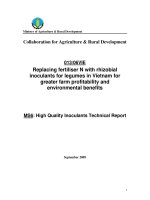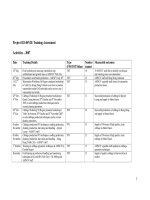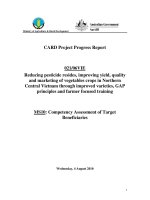Báo cáo khoa học nông nghiệp " FRUIT FLIES AND THEIR CONTROL BY USING PROTEIN BAIT IN VIETNAM " pdf
Bạn đang xem bản rút gọn của tài liệu. Xem và tải ngay bản đầy đủ của tài liệu tại đây (47.46 KB, 7 trang )
GAP Workshop in Binh Thuan (21-22/7/2008)
1
FRUIT FLIES AND THEIR CONTROL BY USING PROTEIN BAIT
IN VIETNAM
Le Duc Khanh, Dao Dang Tuu, Nguyen Thi Thanh Hien,
Tran Thanh Toan, Vu Thi Thuy Trang, Phan Minh Thong, Vu Van thanh, Dang Dinh Thang
1. Introduction and Research Objectives
Fruit fly is one the most serious insect pests of fruit and vegetable planted throughout the world. This is
great concern to farmers, as it causes substantial loses in quantity and quality. Up to 100% of guava can
become infected in the Mekong Delta while in North Vietnam 70 to 100% of peach crops in June – July
(2000, were reported to be infected [2]). All most vegetable and fruits can be infected by fruits flies
including cucurbits, citrus, litchi, and dragon fruit Many species of fruit flies are quarantine pests in
various countries and export of susceptible fruit is not allowed without recognized disinfestations
practices. This problem prevents the economic export of fruit from Vietnam.
Since 1999, the Technical Cooperation on fruit fly with Australian Center for International Agricultural
Research (ACIAR) with National Institute for Plant Protection (NIPP) has been operational. The results
identified the distribution and species and levels of infestation by fruit fly and the use of protein baits to
control fruit flies. These papers display the results at some locations in 2001 to 2007.
2. Materials and Methods
Trapping collected fruit flies
Fruit fly traps were set up with the attractant methyl eugenol (ME) or Culure (CuE), which are specific
for different fruit fly species. The traps were emptied at intervals of one or two weeks depending on the
location, at weekly intervals in Hanoi but two weekly at other locations.
Location of traps:
- Mountain rural : Dien bien, Son la, Hoa binh, Thai nguyen, Ha giang, Lang son, Yen bai, Lao cai
province
- Mountain low: Bac Giang, Phu Tho province
- Red river delta: Ha Noi, Vinh Phuc, Hai Phong, Ninh Binh, Ha Nam
- Northen centre: Nghe An, Thua Thien Hue
Host fruit surveys
Host fruit surveys involved collecting samples of commercial/edible and wild fruits and incubating them
in container for two to three weeks in laboratory to determine where flies emerge from the fruits
Levels of infestations
Collecting samples to find the number of larvae per fruit and percentage of fruits infested in each
commodity, and the stage of maturity when attacked.
Control by using protein bait
Treatment was applied on peach, luffa, guava…
Mixing: 100ml Ento – Pro, 0,1 Regent 800WG and 0,9 lit clean water
Pray 50ml mix liquid underside of leave of 1m
2
Treated 1, 5 to 2 months pre-harvest
100 fruits were collected from each commodity that was treated and not treated with protein bait And
the number of larvae per fruit and percentage of fruits infested in each commodity determined.
GAP Workshop in Binh Thuan (21-22/7/2008)
2
3. Results and discussion
3.1. The species composition
Fruit fly in different ecological area
The fruit fly composition was collected from ME and CuE traps and 23 fruit flies species were
identified. They belong to the Bactrocera and Dacus genus. The Bactrocera genus has three sub-genus
with 21 species. The Dacus genus has two species belong to sub- genus Callantra. The CuE traps
collected 16 fruit flies species but the ME traps collected 5 species .The B. pyrifoliae and B. latifrons
were not collected from the ME and CuE traps.
The results showed that: (i) The number of species in the Mountain rural (MR) areas are more abundant
than in the Mountain low (ML) and Red river delta (RRD). In MR( Son La, Lai Chau, Lao Cai, Lang
Son, Hoa Binh province), 19 species of fruit flies were collected but in the ML (Bac Giang, Phu Tho),
NCC (Nghe An, Thua Thien Hue) and RRD (Ha Noi, Hai Phong, Ha Tay, Vinh Phuc) there were 7 to 10
species.
3.2. Host of fruit flies
A total of 1122 samples (fruits) were collected. There were 831 samples that were infected by fruit flies.
Fruit flies emerged from 34 species of cultivated and wild fruits (Table 1). More than 7 host species of
fruit fly that were not identified in 2000 were collected. 6 fruit flies species emerged from 18 species of
cultivated fruits. 3 fruit flies species emerged from 11 species of vegetable fruits and 4 fruit flies species
emerged from 5 species of wild fruits (Table 2, 3,4).
Table 1. Fruit flies collected on some host in the North and Northern centre (2001-2005)
Number of plant species Number of sample Host
Plants collected Infected plant Sample (fruit
collected)
Fruit infected
Cultivated fruits 31 18 575 483
Vegetable fruits 13 11 366 256
Wild fruits and other 8 5 181 92
Total 52 34 1122 831
Table 2. List of cultivated fruit are host of fruit flies (2001-2005)
Species
TT
Scientific name
BDO BTA BVE BCO BPY BCA
Total
1
Citrus grandis
+ + 2
2
Citrus sinensis
+ 1
3
Citrus reticulata
+ + 2
4
Psidium guajava
+ + 2
5
Prunus persica
+ + + 3
6
Prunus domestica
+ + 2
7
Pyrus communis
+ 1
8
Prunus armeniaca
+ 1
9
Syzygium jambos
+ + 2
10
Dimocarpus longan
+ 1
GAP Workshop in Binh Thuan (21-22/7/2008)
3
11
Nephelium litchi
+ + 2
12
Averrhoa carambola
+ + 2
13
Achras sapota
+ + 2
14
Clausena lansium
+ 1
15
Annona squamosa
+ 1
16
Diospiros kaki
+ 1
17
Ziziphus jujuba
+ + + 3
18
Carica papaya
+ 1
Total
18 1 1 5 3 2
Note: BDO: B. dorsalis; BCO: B. correcta; BPY: B. Pyrifloliae; BCA: B. carambolae;
BCU : B. cucurbitae ; BTA : B. tau; BLA: B. latifrons; BVE : B. verbascifoliae
Table 3. List of vegetable fruit are host of fruit flies (2001-2005)
Species No Scientific name
BCU BTA BLA
Total
1
Cucurbita maxima
+ + 2
2
Luffa aegyptiaca
+ + 2
3
Luffa acutangula
+ + 2
4
Cucumis sativus
+ 1
5
Solanum melongena
+ 1
6
Capsicum annuum
+ 1
7 Benincasa hispida
+ 1
8 Lycopersicon esculentum
+ + 2
9 Lagenaria siceraria
+ 1
10 Momordica cochinchinensis
+ + 2
11
Vigna unguiculata
+ 1
9 5 2
Note : BCU : B. cucurbitae ; BTA : B. tau ; BLA : B. latifrons
Table 4. List of wild fruit are host of fruit flies (2001-2005)
Species
No
Scientific name
BDO BCA BCU
BLA
Total
1
Terminalis bellirica
+ + 2
2
Ficus carica
+ 1
3
Milletia sp. + 1
4
Artabotrys hexapetalus
+ 1
5
Solanum sp. + 1
Total
2 1 2 1
Note: BD: B. dorsalis; BCA: B. carambolae; BCU : B. cucurbitae ; BLA: B. latifrons
3.3. Fruit fly infectation
Assessments of fruit fly infestation were done in 1999 to 2007 on 7 cultivated fruits and one vegetable
crop in some the large cultivated areas. The results showed that all kinds of fruit were severely infected.
GAP Workshop in Binh Thuan (21-22/7/2008)
4
The cultivated fruits were infected from 40 to 45 days before mature fruit harvest time. The fruits were
harvested in summer or autumn. A low percentage infestation during the early season rose quickly
towards the end of the season. For example: in the early season, 4% of the peach crop was infected and
this figure rose to 100% by late season. For litchi this figure is 2% and 10%, for apple (Ziziphus jujuba)
was infected 5% and then rose to 40 % and for Psidium guajava was 4% and 94%.
Fruits that were harvested in late autumn and winter, that has the highest percentage infestation at the
mid- season (51.5% and 100% of Diospiros kaki; 29% of Citrus reticulate , Table 5). In late season this
figure reduced because cold temperature, that unsuitable for fruit flies. The vegetable fruits (Luffa
acutangula) often were infected in young fruits. In spring summer season the fruits were infected more
than in autumn winter (Table 5).
Table 5: The fruit fly infestation on some cultivated fruit and vegetable fruit
(2002 - 2007)
Fruit infected (%) No Kind of fruit Time Local
Early season Mid season Late season
1 Prunus sp. 2002-2005
Moc Chau-Son La
4 50 100
2002 Spring
Summer
Tu Liem -Ha Noi 3 75 100 2
Luffa acutangula
2002 Autumn
Winter
Me Linh - Vinh Phuc
2 4 16
3
Nephelium litchi
2002
Luc Ngan - Bac Giang
0 2 10
4
Ziziphus jujuba
2003
Thuy Nguyen - Hai
Phong
5 28 40
5
Citrus reticulata
2004
Bac Son - Lang Son
22 29 0
2004 2 51.5 7,5 6
Diospiros kaki
2007
Da Bac - Hoa Binh
100 -
Huong Tra - Thua
Thien Hue
4 60 94 7
Psidium guajava
2007
Thanh Ha-Hai Duong 25*
Note: * Fruits were coved by plastic bag
3.4. Control fruit fly by using protein bait
3.4.1. Control fruit fly by protein bait for small area
The use of protein bait sprays on peach, citrus, guajava at Lao cai, Hoa binh, Ha nam, Son la in 1999-
2002. Each orchard is 1,000m
2
to 5,000m
2
. On treated orchard, the infected fruits were reduced but
limited (only 5 to 53%, Table 6).
Table 6: The result control fruit fly using protein bait in some local (1999-2002)
Fruit infected (%) Time Local Kind of fruit
Using protein bait Control
1999 0 60.49
2 000
Sa Pa- Lao Cai Peach
14.00 21.00
1999 Cao Phong- Hoa Binh Orange 7.00 12.00
2000 Thanh Liem-Ha Nam
Guajava
5.00 – 7.00 40 - 60
2002 Moc Chau – Son La Peach 89.00 99.00
GAP Workshop in Binh Thuan (21-22/7/2008)
5
3.4.2. Relation between density population fruit flies trap catch and fruit infected
Results showed that in 2002 the fruit fly traps caught more than twice the number of fruit flies than in
2004. In 2002 (late season) the number of fruit flies traped was reduced by 150 flies/trap (63.10%) over
the controls, but fruit infection was only reduced by 11%. In 2004 the control trapped 109 flies/trap
compared with 26/trap (81.95%), but fruit infection was only 5% (reduced 95% compared with the
untreated the orchard) ( Table 7). The control of fruit fly by using protein bait in large areas reduced the
density fruit fly population and fruit infection.
Table 7. Fruit flies trap catch and peach fruit infected
2002 2004
Treated
Control
Treated
Control
Date
Flies/per
trap
Fruit
infected
(%)
Flies/per
trap
Fruit
infected
(%)
Flies/per
trap
Fruit
infected
(%)
Flies/per
trap
Fruit
infected
(%)
11/5 1
-
0
-
0
13
-
18/5 9 - 7 - 0 0 19 0
25/5 58 0 62 0 0 0 83 0
1/6 306 4.00 372 5.00 0 0 79 0
8/6 368 9.00 445 67.00 0 0 169 1.0
15/6 224 13.00 376 81.00 10 3.00 146 33.00
23/6 311 51.00 593 93.00 25 5.00 96 95.00
30/6 121 89.00 271 100.00 26 4.00 109 100
5/7
24 5.00 133 100
Note: In 2002: the orchard area was 0.5 ha
In 2004, the orchard area was 35 ha
3.4.3. Control fruit fly for large area by protein bait
Control fruit fly on apple (Ziziphus jujuba) at Phuc le - Thuy nguyen – Hai phong in 2003
There are hundreds ha of apple (Ziziphus jujuba) planted at Thuy nguyen – Hai phong. On average each
farmer has planted from 10-50 trees equivalent 300 per 1,000m
2
. Every year fruit resulted in serious
damage to apples from by fruit fly. Sometimes 100% of fruit was lost. The fruit losses were highest at
late September and early October. Chemical control fruit fly was used but had a given low effect, and it
has disadvantages of being unsafe for the environmental and health of people.
Protein bait was used in the all apple area at Nam Phuc le village (8 ha) in 2003.
The result showed that in the late season, in treated orchards were treated, the infected fruits was 4 to
6% while in the untreated orchard,fruit infected was 37% (Table 8).
Table 8. Apple fruit was infected flies at Nam Phuc Le - Thuy Nguyen – Hai Phong in 2003
Infected fruits (%) Date
make sampling
Using protein bait Control
11/10
3.00
5.00
18/10
0
9.00
23/10
6.00
28.00
28/10
4.00
37.00
GAP Workshop in Binh Thuan (21-22/7/2008)
6
Fruit Fly Control on peach at Long luong-Moc Chau – Son La 2004-2005
35 ha of peach at Co long and San cai Long luong – Moc chau was used to measure the impact of
protein bait. In the late season, only 5% of peaches were damaged by fruit fly in these orchards. At the
same time, on the orchards, that were not applying protein bait, almost all peach fruits were damaged
(100% fruit infected) (Table 9).
Table 9. Peach fruit was infected flies at Long Luong-Moc Chau – Son La 2004
Using protein bait Control Date
make
sampling
Sample
(number fruit
collected)
Number fruit
infected
Fruit infected
(%)
Number fruit
infected
Fruit infected
(%)
21/5 100 0 0 0 0
27/5 100 0 0 0 0
2/6 100 0 0 0 0
8/6 100 0 0 1 1.00
16/6 100 3 3.00 33 33.00
21/6 100 5 5.00 95 95.00
26/6 100 4 4.00 100 100
1/7 100 5 5.00 100 100
In 2005 this trial was repeated applying protein bait on 35 ha of peaches. Experimental results indicate
that bait spraying is the most effective treatment. This method of fruit fly control through using protein
bait on large areas of apples and peaches has provided a very successful result.
Table 10. Peach fruit was infected flies at Longluong-Mocchau – Sonla 2005
Using protein bait Control Date
make
sampling
Sample (number
fruit collected)
Number fruit
infected
Fruit infected
(%)
Number fruit
infected
Fruit infected (%)
9/5 100 0 0 0 0
3/6 100 0 0 0 0
15/6 100 0 0 0 0
20/6 100 0 0 6 6.0
25/6 100 3 3.00 41 41.00
4/7 100 2 2.00 79 79.00
17/7 100 4 4.00 100 100
3.4.4. Control fruit fly by using protein bait for large area in some provinces
After some experiment to control fruit fly by using protein bait for large area of apple and peach in
2003-2005 research work continued through applying treatments for peach, Psidium guava and
Diospiros kaki in some provinces from 2006 to 2007.
GAP Workshop in Binh Thuan (21-22/7/2008)
7
Table 11. Control fruit fly by protein bait for large area in some provinces
Infected fruits (%) Time Location Area
(ha)
Species
Treated Control
2006 Mocchau Sonla 35 Peach 4.00 100
2007 Mocchau Sonla 35 Peach 4.00 100
2007 Huongtra Thuathienhue 10
Psidium guava
4.00 94.00
2007 Thanhha Haiduong 50
Psidium guava
5.00 25.00*
2007 Dongdu Hanoi 1
Psidium guava
9.50 96.50
2007 Dabac Hoabinh 7,5
Diospiros kaki
8.00 95.00
Note: * Fruits were coved by plastic bag
In all locations, control of fruit fly in large areas produces good results. The infected fruit was only 4.00
to 5.00%, while for untreated fruit this figure was 94.00 to 100%. For fruit (Psidium guava) that was
covered by plastic bags, the infected fruit was 25%. The infected fruit reached 9.50% for the treated
small area (Table 11).
4. Conclusion and suggestion
Conclusion
- There are many different fruit flies species in the North and mid Northern regions. There were 23
fruit flies species collected, of which 8 species cause high levels of damage on cultivated fruit and
vegetables.
- Fruit flies emerged from 34 plant species. Among them 18 species of cultivated fruits, 11 species
of vegetable fruits and 5 species of wild fruits. 7 new host species of fruit fly, not previously
collected were identified.
- Fruit fly causes serious damage seriously on 6 important cultivated plant species. Rate of infected
in late season was 100% with peaches, 100% in spring summer luffa (spring summer), 10% in
litchi, 40% in apple (Ziziphus jujuba), 29% in yellow citrus (mid season), 52% in Diospiros kaki,
25 - 60% in Psidium guajava.
- Control of fruit fly by using protein bait for large areas gave excellent results. The damaged fruit
was only 6% in apple, 5% in peach and 4.0 to 9.5% in Psidium guava (reduced 25.0- 95%),
Suggestion:
The protein bait for control of fruit flies model needs to be applied on large areas in order to give
high effect and to provide safe commodities for domestic and export markets.
References
1. Allwood A.J., L. Leblanc, 1996. Losses caused by fruit flies (Diptera: Tephritidae) in seven Pacific
Island countries, Management of fruit flies in the pacific, ACIAR proceedings N
0
76
2. Dick Drew R.A.I., Ha Minh Trung, Le Duc Khanh, 2001 Reasults of fruit fly project in Vietnam
code TCP/VIE/8823(A) 1999-2000
3. Leweri L. 1996. Management of fruit flies in the Pacific, ACIAR proceeding N
0
76









